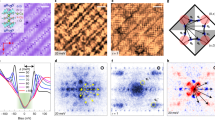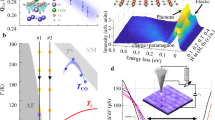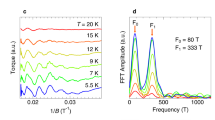Abstract
A key question in condensed-matter physics is to understand how high-temperature superconductivity emerges on adding mobile charged carriers to an antiferromagnetic Mott insulator. We address this question using angle-resolved photoemission spectroscopy to probe the electronic excitations of the non-superconducting state that exists between the Mott insulator and the d-wave superconductor in Bi2Sr2CaCu2O8+δ. Despite a temperature-dependent resistivity characteristic of an insulator, the excitations in this intermediate state have a highly anisotropic energy gap that vanishes at four points in momentum space. This nodal-liquid state has the same gap structure as that of the d-wave superconductor but no sharp quasiparticle peaks. We observe a smooth evolution of the excitation spectrum, along with the appearance of coherent quasiparticles, as one goes through the insulator-to-superconductor transition as a function of doping. Our results suggest that high-temperature superconductivity emerges when quantum phase coherence is established in a non-superconducting nodal liquid.
This is a preview of subscription content, access via your institution
Access options
Subscribe to this journal
Receive 12 print issues and online access
$259.00 per year
only $21.58 per issue
Buy this article
- Purchase on SpringerLink
- Instant access to full article PDF
Prices may be subject to local taxes which are calculated during checkout



Similar content being viewed by others
References
Kastner, M. A. & Birgenau, R. J. Magnetic, transport, and optical properties of monolayer copper oxides. Rev. Mod. Phys. 70, 897–928 (1998).
Tsuei, C. C. et al. Robust d x 2 − y 2 pairing symmetry in hole-doped cuprate superconductors. Phys. Rev. Lett. 93, 187004 (2004).
Konstantinovic, Z., Li, Z. Z. & Raffy, H. Normal state transport properties of single- and double-layered Bi2Sr2Can−1CunOy thin films and the pseudogap effect. Physica C 341–348, 859–862 (2000).
Oh, S., Crane, T. A., Van Harlingen, D. J. & Eckstein, J. N. Doping controlled superconductor-insulator transition in Bi 2 Sr 2 x La x CaCuO 8 − δ . Phys. Rev. Lett. 96, 107003 (2006).
Matei, I., Li, Z. Z. & Raffy, H. Observation of the superconducting-insulating transition in a BiSr(La)CuO thin film tuned by varying the oxygen content. J. Phys.: Conf. Ser. 150, 052154 (2009).
Campuzano, J. C. et al. Electronic spectra and their relation to the (π, π) collective mode in high-Tc superconductors. Phys. Rev. Lett. 83, 3709–3712 (1999).
Norman, M. R. et al. Destruction of the Fermi surface in underdoped high-Tc superconductors. Nature 392, 157–160 (1998).
Kaminski, A. et al. Identifying the background signal in angle-resolved photoemission spectra of high-temperature cuprate superconductors. Phys. Rev. B 69, 212509 (2004).
Kanigel, A. et al. Evolution of the pseudogap from Fermi arcs to the nodal liquid. Nature Phys. 2, 447–451 (2006).
Doiron-Leyraud, N. et al. Onset of a Boson mode at the superconducting critical point of underdoped YBa2Cu3Oy . Phys. Rev. Lett. 97, 207001 (2006).
Huefner, S., Hossain, M. A., Damascelli, A. & Sawatzky, G. A. Two gaps make a high-temperature superconductor? Rep. Prog. Phys. 71, 062501 (2008).
Mesot, J. et al. Superconducting gap anisotropy and quasiparticle interactions: A doping dependent photoemission study. Phys. Rev. Lett. 83, 840–843 (1999).
Tanaka, K. et al. Distinct Fermi-momentum–dependent energy gaps in deeply underdoped Bi2212. Science 314, 1910–1913 (2006).
Ma, J.-H. et al. Coexistence of competing orders with two energy gaps in real and momentum space in the high temperature superconductor Bi2Sr2−xLaxCuO6+δ . Phys. Rev. Lett. 101, 207002 (2008).
He, R.-H. et al. Energy gaps in the failed high-Tc superconductor La1.875Ba0.125CuO4 . Nature Phys. 5, 119–123 (2009).
Pushp, A. et al. Extending universal nodal excitations optimizes superconductivity in Bi2Sr2CaCu2O8+δ . Science 324, 1689–1693 (2009).
Lee, J. et al. Spectroscopic fingerprint of phase incoherent superconductivity in the pseudogap state of underdoped Bi2Sr2CaCu2O8+δ . Science 325, 1099–1103 (2009).
Sutherland, M. et al. Thermal conductivity across the phase diagram of cuprates: Low-energy quasiparticles and doping dependence of the superconducting gap. Phys. Rev. B 67, 174520 (2003).
Shi, M. et al. Coherent d-wave superconducting gap in underdoped La2−xSrxCuO4 by angle-resolved photoemission spectroscopy. Phys. Rev. Lett. 101, 047002 (2008).
Valla, T. et al. The ground state of the pseudogap in cuprate superconductors. Science 314, 1914–1916 (2006).
Meng, J. et al. Monotonic d-wave superconducting gap of the optimally doped Bi2Sr1.6La0.4CuO6 superconductor by laser-based angle-resolved photoemission spectroscopy. Phys. Rev. B 79, 024514 (2009).
Wei, J. et al. Superconducting coherence peak in the electronic excitations of a single-layer Bi2Sr1.6La0.4CuO6+δ cuprate superconductor. Phys. Rev. Lett. 101, 097005 (2008).
Meng, J. et al. Direct observation of Fermi pocket in high temperature cuprate superconductors. Preprint at <http://arxiv.org/abs/0906.2682> (2009).
Hetel, I., Lemberger, T. R. & Randeria, M. Quantum critical behaviour in the superfluid density of strongly underdoped ultrathin copper oxide films. Nature Phys. 3, 700–702 (2007).
Wang, Y., Li, L. & Ong, N. P. Nernst effect in high-Tc superconductors. Phys. Rev. B 73, 024510 (2006).
Li, L., Chechelsky, J. G., Komiya, S., Ando, Y. & Ong, N. P. Low-temperature vortex liquid in La2−xSrxCuO4 . Nature Phys. 3, 311–314 (2007).
Shen, K. M. et al. Fully gapped single-particle excitations in lightly doped cuprates. Phys. Rev. B 69, 054503 (2004).
Anderson, P. W. et al. The physics behind high-temperature superconducting cuprates: The ‘plain vanilla’ version of RVB. J. Phys. Condens. Mater. 16, R755–R799 (2004).
Balents, L., Fisher, M. P. A. & Nayak, C. Nodal liquid theory of the pseudo-gap phase of high-Tc superconductors. Int. J. Mod. Phys. B 12, 1033–1068 (1998).
Tesanovic, Z. d-wave duality and its reflections in high-temperature superconductors. Nature Phys. 4, 408–414 (2008).
Acknowledgements
Work supported by the US National Science Foundation under grant DMR-0606255 (J.C.C.), NSF-DMR 0706203 (M.R.), and the US Department of Energy, Office of Science, under contract Nos DE-AC02-06CH11357 and DE-AC02-98CH10886. The Synchrotron Radiation Center, University of Wisconsin-Madison, is supported by the National Science Foundation under Award No. DMR-0537588.
Author information
Authors and Affiliations
Contributions
Project planning: J.C.C.; sample preparation: H.R., Z.Z.L., K.K., D.G.H., Z.J.X., J.S.W., G.G. and C.T.L.; ARPES experiments: U.C., M.S., D.A., J.Z., A.K. and S.R.; resistivity measurements: H.R. and Z.Z.L.; susceptibility measurements: H.C.; data analysis: U.C., M.S., D.A., A.K., M.R.N. and J.C.C.; manuscript preparation: U.C., M.R.N., M.R. and J.C.C.
Corresponding author
Supplementary information
Supplementary Information
Supplementary Information (PDF 473 kb)
Rights and permissions
About this article
Cite this article
Chatterjee, U., Shi, M., Ai, D. et al. Observation of a d-wave nodal liquid in highly underdoped Bi2Sr2CaCu2O8+δ. Nature Phys 6, 99–103 (2010). https://doi.org/10.1038/nphys1456
Received:
Accepted:
Published:
Issue date:
DOI: https://doi.org/10.1038/nphys1456
This article is cited by
-
Unveiling phase diagram of the lightly doped high-Tc cuprate superconductors with disorder removed
Nature Communications (2023)
-
The emergence of global phase coherence from local pairing in underdoped cuprates
Nature Physics (2023)
-
Observation of a d-wave gap in electron-doped Sr2IrO4
Nature Physics (2016)
-
Energy gaps in high-transition-temperature cuprate superconductors
Nature Physics (2014)
-
Disappearance of nodal gap across the insulator–superconductor transition in a copper-oxide superconductor
Nature Communications (2013)



